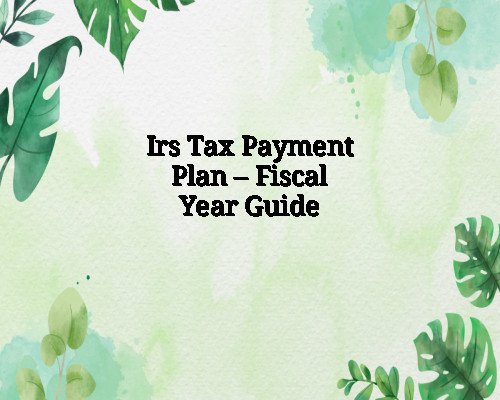IRS Tax Payment Plan – Fiscal Year Guide
If you’re facing difficulty paying your tax bill in full, an IRS tax payment plan can help you manage the financial burden. With this option, you can pay your taxes over time, ensuring that you stay compliant while avoiding severe penalties and interest. Here’s a detailed guide to understanding and navigating the IRS tax payment plan system for the fiscal year.
An IRS tax payment plan is an arrangement with the Internal Revenue Service (IRS) that allows taxpayers to pay their owed taxes in installments over a period of time. This can be a lifeline if you’re unable to pay the full amount due at once, but it’s important to understand how these plans work, the different types available, and the steps needed to get on a payment plan.
What Is an IRS Tax Payment Plan?
An IRS tax payment plan is a method of paying taxes over time. Instead of settling the full tax bill at once, you can spread your payments across several months or even years, depending on your financial situation.
The IRS offers two primary types of payment plans:
-
Short-Term Payment Plan
-
Long-Term Payment Plan (Installment Agreement)
Short-Term Payment Plan
A short-term payment plan is typically available if the amount owed is $100,000 or less, including penalties and interest, and if you can pay off the full balance within 120 days. This is ideal for individuals or businesses that expect to have the money to pay off the debt in the near future but need more time to gather the necessary funds. No setup fee is required, but interest and penalties will continue to accrue until the balance is paid in full.
Long-Term Payment Plan (Installment Agreement)
A long-term payment plan, or installment agreement, allows you to pay off your taxes over a more extended period, typically longer than 120 days. This option is available for balances over $50,000, and you can spread your payments over up to six years (72 months). However, keep in mind that the IRS will continue to charge interest and penalties while you’re on the plan.
There are two types of long-term plans:
-
Direct Debit Installment Agreement: Payments are automatically withdrawn from your bank account. This is often the easiest and most convenient option, as it ensures timely payments and may reduce the setup fee.
-
Regular Installment Agreement: You make manual payments, which may involve more paperwork and higher fees compared to the direct debit option.
Eligibility for an IRS Payment Plan
To qualify for an IRS tax payment plan, you must meet specific eligibility criteria, which can vary depending on the amount owed and your financial situation. Here are some general rules:
-
You must have filed all required tax returns. If you’re behind on filing, the IRS may reject your application for a payment plan until you have filed your returns.
-
You must be up to date on all federal tax obligations. If you’re in the middle of an audit or facing other complications with the IRS, this may affect your eligibility.
-
Your tax liability must meet the minimum thresholds for a short-term or long-term plan.
How to Apply for an IRS Tax Payment Plan
Step 1: Determine Which Payment Plan Is Right for You
Before applying for a payment plan, assess your financial situation. If you can pay the full balance within 120 days, a short-term payment plan may be sufficient. However, if you need more time to pay off the balance, consider applying for a long-term installment agreement.
Step 2: Submit Your Application
The IRS offers several ways to apply for a payment plan:
-
Online Application: The easiest way to apply is through the IRS website, which offers an online application for both short-term and long-term plans. This is a convenient option for those who owe $50,000 or less in combined taxes, penalties, and interest.
-
Phone or Mail Application: If you owe more than $50,000, or if you prefer not to apply online, you can submit your application by phone or mail. This requires additional paperwork, and you may be asked to provide financial information.
-
Form 9465: This is the official IRS form used to apply for a long-term payment plan. You can file this form online or submit it by mail.
Step 3: Wait for IRS Approval
Once your application is submitted, the IRS will review your request. If you’re applying for a long-term plan and your balance is over $10,000, the IRS may ask for additional financial documentation to determine your ability to pay. If your application is approved, you’ll receive a notice outlining your payment schedule.
If you’re denied, you can appeal the decision. In some cases, the IRS may offer alternative solutions, such as a temporary delay in payment, or you may be able to negotiate the terms of your agreement.
Costs and Fees Associated with IRS Tax Payment Plans
While an IRS payment plan can provide valuable relief, there are costs and fees associated with setting up and maintaining the plan. Here’s a breakdown of potential costs:
Setup Fees
-
Short-Term Plan: No fee if the balance is paid in full within 120 days.
-
Long-Term Plan: Fees vary based on the type of agreement and the payment method. For example, the fee for setting up a direct debit installment agreement is typically lower than for a regular installment agreement. These fees can range from $31 to $225, depending on the specifics of the payment plan.
Interest and Penalties
Even while on a payment plan, the IRS continues to charge interest and penalties on the outstanding balance. The interest rate is typically set at the federal short-term rate plus 3%, and penalties for failure to pay taxes on time may also apply. These fees can add up over time, so it’s important to pay as much as possible during the life of the plan to minimize the impact.
Benefits of an IRS Tax Payment Plan
-
Avoid Penalties: While you may still incur penalties and interest, entering into a payment plan will prevent more severe actions, such as wage garnishments or bank levies.
-
More Time to Pay: Payment plans allow you to pay off your tax liability over time, which can ease the financial strain.
-
Peace of Mind: Knowing that you have a structured plan in place to pay your taxes can reduce anxiety and help you stay focused on meeting your financial goals.
Common Mistakes to Avoid
When applying for an IRS payment plan, avoid these common pitfalls:
-
Missing Payments: It’s essential to stick to your payment schedule. Missing a payment can lead to penalties, interest, and even the cancellation of your plan.
-
Not Updating Your Information: If your financial situation changes, such as a job loss or income change, inform the IRS immediately to avoid complications.
-
Failing to File Taxes: You must stay current on all tax filings, even if you’re on a payment plan. Failure to file could result in the IRS revoking your plan and pursuing more aggressive collection tactics.
Conclusion
An IRS tax payment plan can be a valuable tool to help taxpayers manage their tax debt without facing overwhelming financial hardship. Whether you opt for a short-term plan or a long-term installment agreement, it’s essential to understand the process, associated costs, and the requirements for maintaining your plan. By staying proactive, paying on time, and keeping the IRS informed of any changes, you can navigate your tax obligations with confidence and ensure a smoother financial future.

